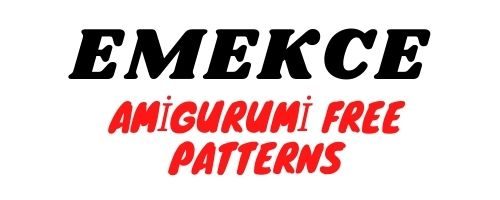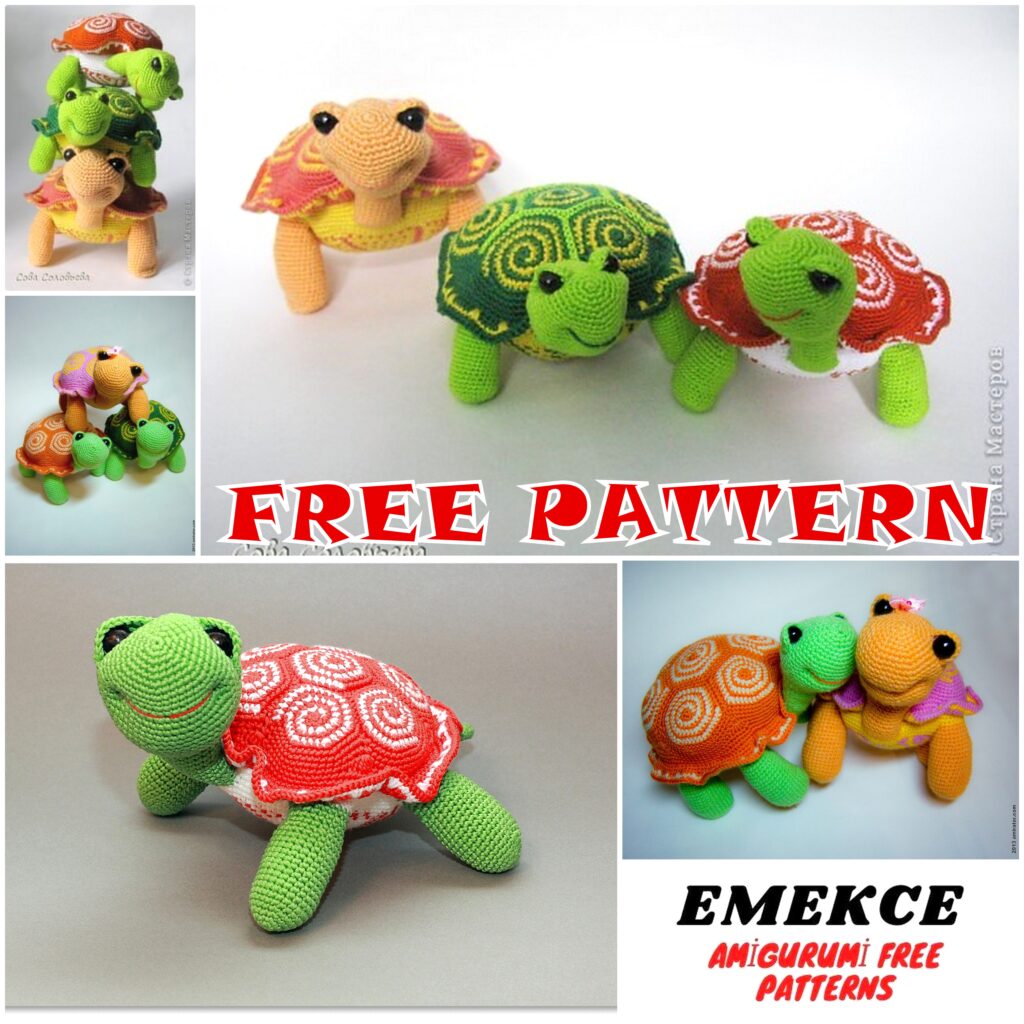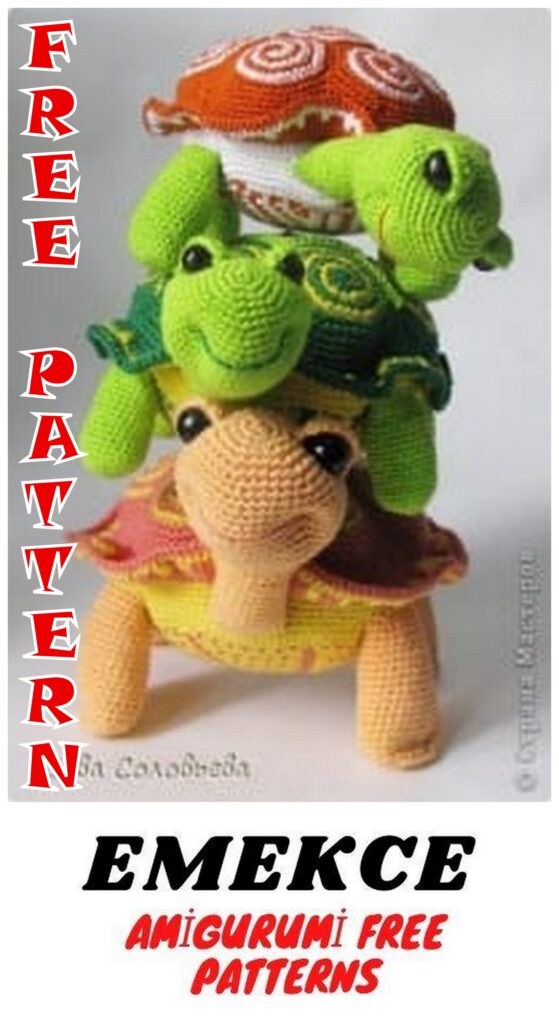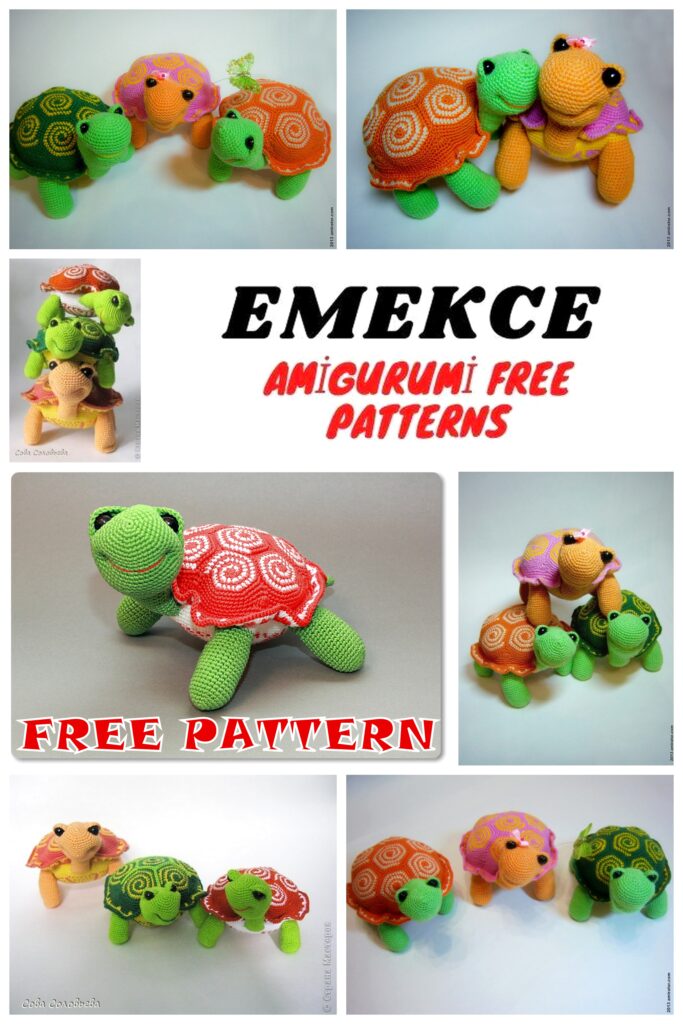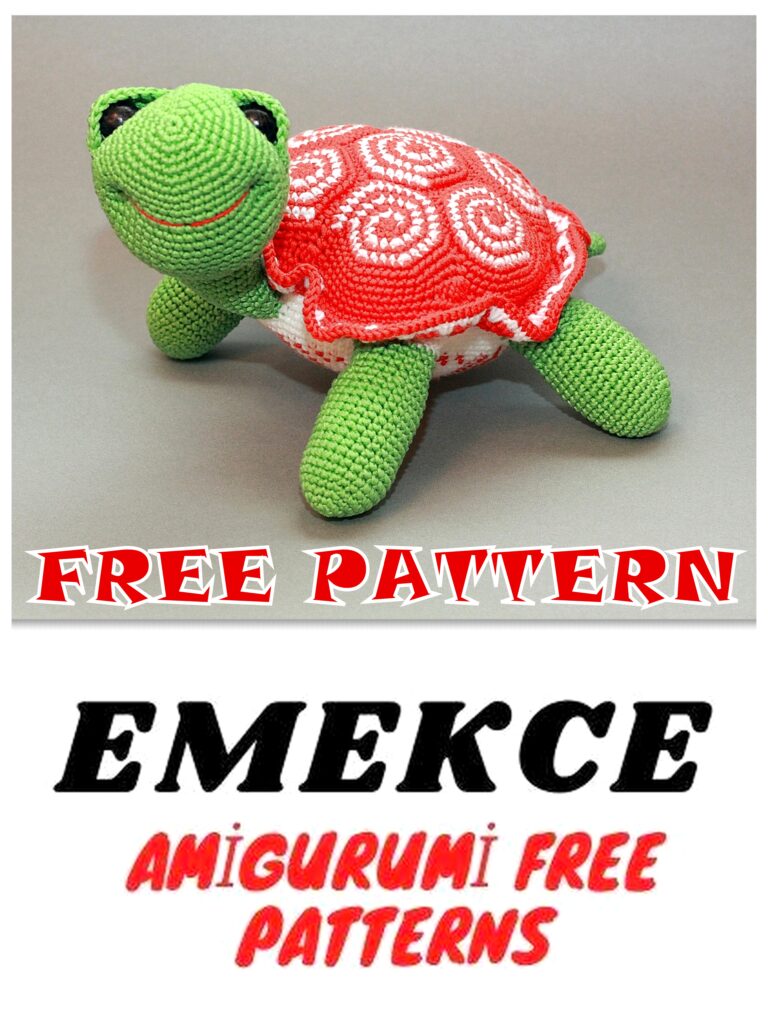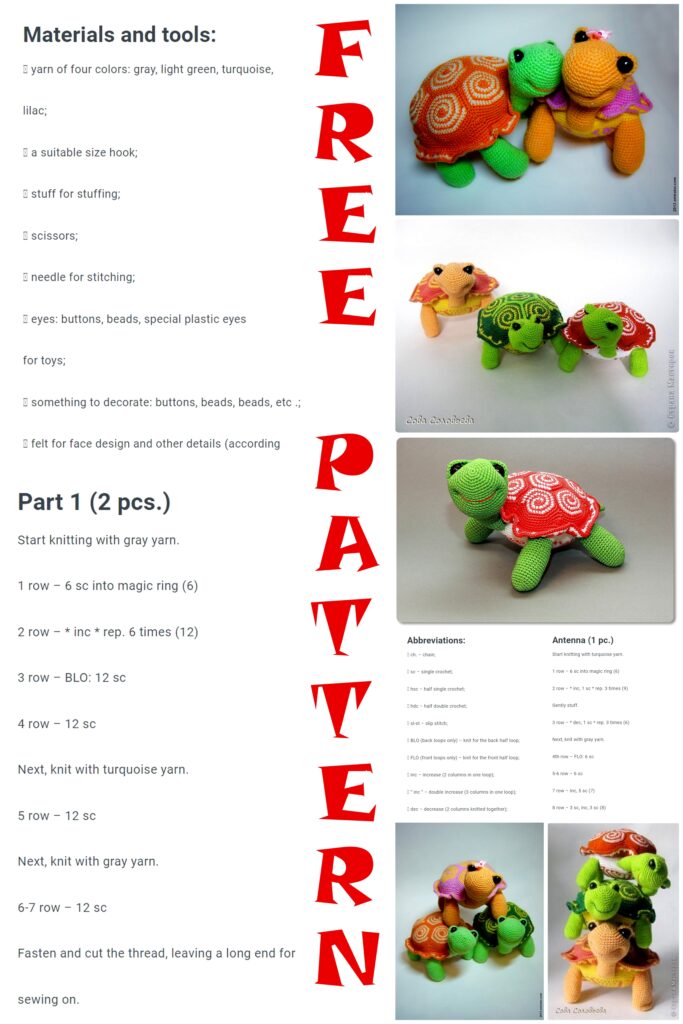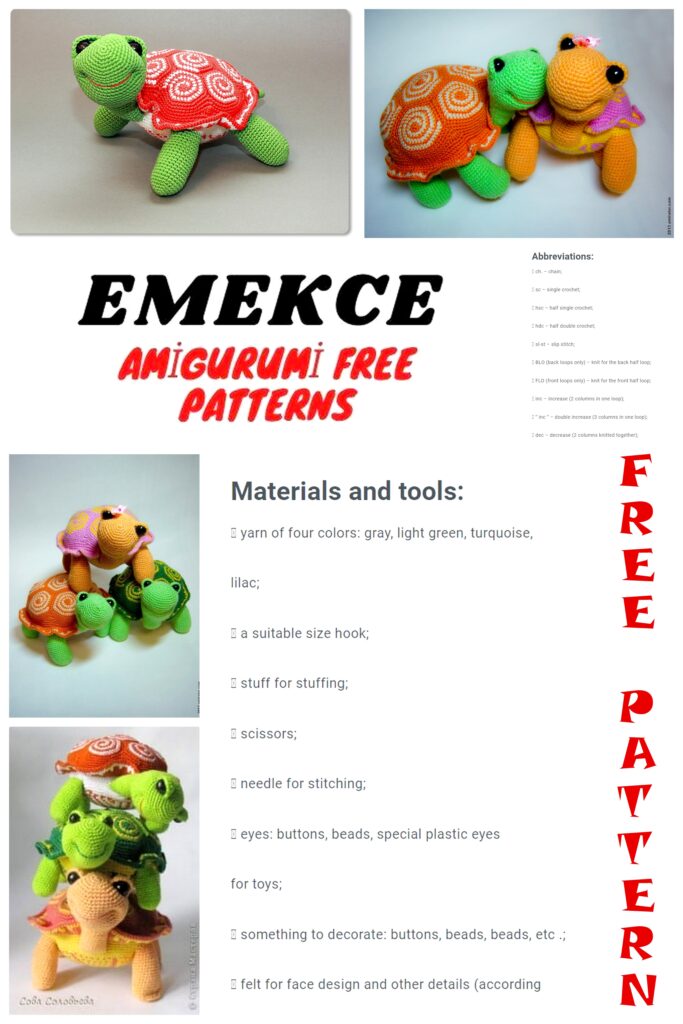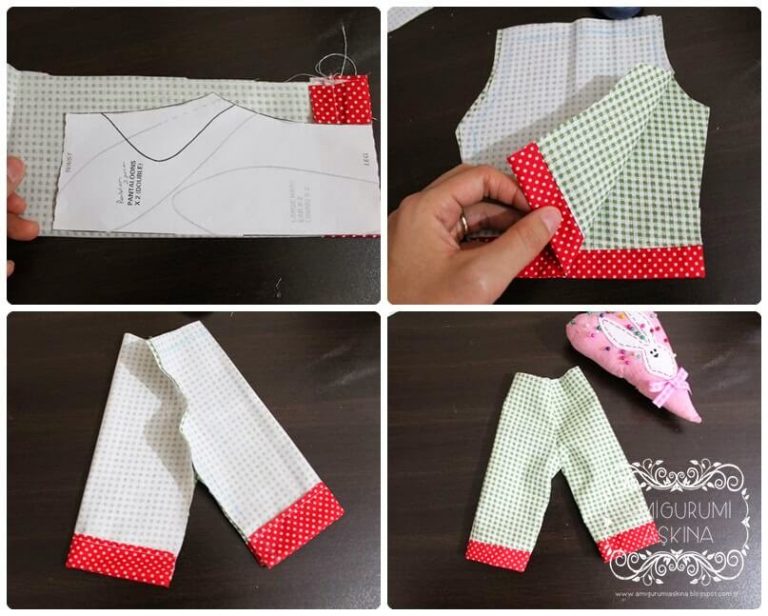Rainbow Cute Turtle Amigurumi Free Crochet Pattern
Best quality and free amigurumi animal patterns on this site. In this article, we shared with you the amigurumi turtle pattern
Turtles
we need threads of three colors, wire, beads for the eyes, a hook for your threads.
in the photo, pay attention to the proportions of the turtles: in the yellow-green turtle, the head-legs-tail are tied from a thread thinner (hook No. 0.9) than the shell-belly (hook No. 1.25), peach and reddish-white-green turtle knitted from threads of the same thickness.
As soon as we have decided on the threads, we proceed to the most monotonous:
Head.
1.6 sc in amigurumi ring
2. (sc, inc) 6 times
3. (2 sc, inc) 6 times
4. (3 sc, inc) 6 times
5. (4 sc, inc) 6 times
636 sc
7. (5 sc, inc) 6 times
8.42 sc
9. (6 sc, inc) 6 times
10.48 sc
11. (7 sc, inc) 6 times
12-14 rows 54 sc
15. (7 sc, dec) 6 times
16.48 sc
17. (6 sc, dec) 6 times
18.42 sc
19. (5 sc, dec) 6 times
20 – 22 rows 36 sc
23. (4 sc, dec) 6 times
24.30 sc
25.12 sc, (sc, dec) 6 times (this will be the chin, the bottom of the head)
26 – 29 rows 24 sc
30. (10 sc, dec) 2 times
31 – 36 rows 22 sc
37. (9 sc, dec) 2 times
38 and 39 rows 20 sc
Leg (4 pcs).
1.5 ch, starting from the second loop from the hook:
2.3 sc, 3 sc at last, 2 sc, 2 sc at last
3.inc, 2 sc, 3 inc, 2 sc, 2 inc
4.sc, inc, 2 sc, (sc, inc) 3 times, 2 sc, (sc, inc) 2 times
5.2 sc, inc, 2 sc, (2 sc, inc) 3 times, 2 sc, (2 sc, inc) 2 times
6 – 18 rows (13 rows) sc in each loop of the previous row
19.2 sc, dec, 2 sc, (2 sc, dec) 3 times, 2 sc, (2 sc, dec) 2 times
Rows 20 and 21 sc in each loop of the previous row
22. (9 sc, dec) 2 times
23.20 sc
Tail.
4 sc in amigurumi ring
1.4 sc
2.inc, 4 sc
3.inc, 5 sc
and then one increase in a row until 14 loops are typed.
finished with the boring part, let’s get down to the “sweet”.
Shell motif.
6 sc in amigurumi ring
Red them 2 increments
Attach a white thread to the next loop, knit 3 increments (starting with the loop next after the one in which you attached the thread)
Red-haired increase in the loop into which you attached the white thread.
We have three white and three red
Then we knit in a circle, separately in turn with each thread:
Redhead in white loops (sc, inc) 2 times
White in red loops (sc, inc) 3 times
Redhead in white loops sc, inc, (2 sc, inc) 2 times
White in red loops (2 sc, inc) 3 times
Redhead in white loops 2 sc, inc, (3 sc, inc) 2 times
White in red loops (3 sc, inc) 3 times
Redhead in white loops 3 sc, inc, (4 sc, inc) 2 times
White in red loops (4 sc, inc) 2 times, 4 sc, in the next sc loop and connecting column, break the white thread.
Red in white loops 4 sc, inc, (5 sc, inc) 2 times, 5 sc, increase in red loop (see photo)
Red in red loops (5 sc, inc) 3 times, finish work, break the thread.
we knit seven such motifs.
Assembling the shell.
The motives, folding “face to face”, are connected by three sides with single crochet columns.
Next, we tie along the common outer edge.
1.sc in each loop (126 loops)
2.sc, (19 sc, dec) 6 times, and the decrease should be at the junction between the motives, i.e. you grab one loop of one motive and one loop of another motive and make a decrease (120 loops)
3. (dec, 15 sc, dec, sc) 6 times, and sc between the decreases must fall into the joint between the motives (in the decrease of the previous row).
4. (hdc, 15 sc, hdc, 3 dc in one loop) 6 times, and 3 dc should fall into the joint between the motives (in sc between the decreases of the previous row).
Rows 5, 6 and 7 120 sc proceed to the tummy.
The basis of the pattern on the belly is that all the additions are made with a thread of an additional color, it will look like rays from the center.
Everything between the beams is at your discretion, you can randomly insert colored loops (as in my case), you can not make beams, but start a spiral, as on the motives of the shell, you can generally make the tummy monotonous.
1.7 sc in amigurumi ring
2.7 increments
3. (sc, inc) 7 times
4. (2sc, inc) 7 times
5. (3sc, inc) 7 times
6. (4sc, inc) 7 times
7. (5sc, inc) 7 times
8. (6sc, inc) 7 times
9. (7sc, inc) 7 times
10. (8sc, inc) 7 times
11. (9sc, inc) 7 times
12. (10sc, inc) 7 times
13. (11sc, inc) 7 times
14. (12sc, inc) 7 times
15. (13sc, inc) 7 times
16. (14sc, inc) 7 times
17. (15sc, inc) 7 times
Rows 18 and 19 sc in each loop of the previous row, do not break the thread.
Next, we tie the limbs to the belly as follows:
11 sc, 10 sc grabbing the leg (as in the photo), 10 sc, 10 sc grabbing the leg, 10 sc, 10 sc grabbing the head (chin to the belly, remember where the decreases are on the neck?), 10 sc, 10 sc grabbing the leg, 10 sc, 10 sc grabbing the leg, 12 sc, 7 sc grabbing the tail, we get the next figure.
Next row – sc in each loop of the previous row, but grabbing the remaining free loops of the limbs and head.
2 more rows sc in each loop of the previous row, fasten and break the thread.
Making a frame. A piece of wire from the tail to the head, and two more, connecting the legs in pairs.
Insert the frame. It is not necessary to connect the legs and the ridge together.
After the frame is inserted, we fill the head and legs. not very tight, so that later it would be convenient to tighten.
Then we tie the shell to the tummy.
First, attach the shell to the resulting organism so that the legs, head and tail are centered between the shell motifs.
We attach the thread to the shell and connect the shell and abdomen with a loop into a loop. The process is quite tedious, but be patient.
We don’t tie it to the end, leave a hole somewhere between the last leg and the tail, and stuff the carcass.
first the tummy (under the frame), then the shell (above the frame), starting from the far edge, so that the motifs of the shell stand out in relief.
we tie the row to the end.
yes, on the carapace we have an extra loop (belly 119 loops, and carapace 120), we hide it somehow in the tail area at the end of the row, it will not be noticeable there.
we do not break the thread, we knit it further.
2nd row – 2 sc, inc to end of row.
3rd and 4th rows sc in each loop of the previous row
5th row 3 sc, inc knit with a thread of a different color, and we make the increments in the loop of the previous row (see photo)
6th row change the thread to the main one, sc in each loop of the previous row, fasten and break the thread.
and proceed to the design of the head.
we embroider the mouth so that the stitches lie exactly between the rows.
making eyes.
we insert the needle into the corner of the mouth, and we draw it out at the location of the eye, we catch the bead-eye, we stick the needle where it was pulled out, and we take it out one loop further than it was originally introduced. I hope, at least a little bit clear what I mean))
we tighten the cheek: at the same time a smile is formed and the eye is pressed into the head. We tie the ends of the thread tightly to fix the position.
we repeat the operation on the other side.
we get a smiling, but still somewhat inadequate turtle))
to return the lady to adequate, you need to make her eyelids.
I knitted eyelids according to the following pattern:
10ch
from the second loop 9 sc
from the second loop sl-st, sc, 3 hdc, sc, sl-st, ch
sl-st, 4 sc, 2 sl-st, ch
from the second loop sl-st, sc, inc. 2 sc, 2 sl-st, ch
from the second loop sl-st, 5 sc, 3 sl-st, ch. leave the end of the thread for sewing.
and here, as they say, I found a scythe on a stone. the size and pattern of the eyelid depends solely on the size and shape of the bead that will be your turtle’s eye! therefore, my scheme more than likely simply will not suit you ((all I can advise is knit at random, applying to the eye all the time, and make corrections along the way, and write down everything that you did so as not to fool at least with the second eyelid …
in general, the shape of the eyelids should be something like this:
using pins we try on the eyelids. when we have found a position that suits you, we sew on the eyelids.
we hide all the ends of the threads inside.
our turtle is ready!
